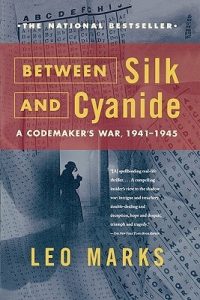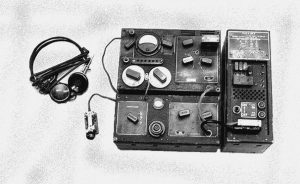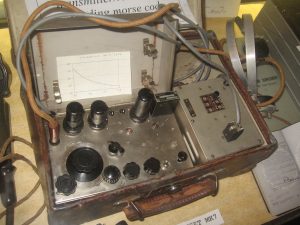That Recognisable Fist- The CW operators’ fingerprint
 THE OPERATORS FIST CHRIS G0EYO EXPLORES THE CLANDESTINE WORLD OF WORLD WAR II CW OPERATORS .
THE OPERATORS FIST CHRIS G0EYO EXPLORES THE CLANDESTINE WORLD OF WORLD WAR II CW OPERATORS .
Many of us will have read the stories of W/T operators during WW2 being recognisable by their style of sending, otherwise known as the Operator’s Fist or Fingerprint. In a book I have just read about Code Writing and Code Breaking in the S.O.E *. by Leo Marks, ** he explains at some length why it was important to be able to recognise the operator at the other end of the link. Agents sent into Europe by SOE often had a W/T operator accompanying them. According to Marks, W/T operators fell into two categories; those who sent from the wrist and those who sent from their elbows.
Apparently, the elbow senders where more consistent in their sending than the wrist senders. The operator’s receiving the W/T traffic (known as” Signal Masters”) had to distinguish between errors caused by “stress” or “morse cramp” – colloquially known as “morse mutilation”; (don’t forget,these agents are sending under extreme pressure. Germans with D/F vehicles were constantly hunting for them), or errors caused by the changing propagation, or “atmospherics”.
The Signal Masters could always distinguish between mis-transmitted groups and morse mutilated ones for a very simple reason: poor atmopheric conditions affected all the code groups, often making the clear-text impossible to read, whereas an operator’s mistake affected only individual letters

Type 3 MK II otherwise known as the B2. The UK version of the Spy Radio. Image reproduced by kind permission of the owner Steen Wichmand OZ8SW
S.O.E. realised that the W/T operator’s touch on the keyboard was as individual as a fingerprint. so detailed recordings were made of every operator’s “fist” before he or she left for the field. The operators were instructed to transmit every letter of the alphabet at varying speeds, followed by every numeral, but were given no warning that they were being “fingerprinted” to avoid self-conscious transmissions. Their dots, dashes and Morse hesitations were then transferred to a paper tape which moved at 16 feet per minute. This magnified even the smallest Morse dots by quarter of an inch, allowing an in-depth study to be made of every operator’s style. The on square-ruled paper and lodged with the chief Signal Masters at the WT stations.
When the operators reached the field, their “fists” varied from message to message, responding to the tensions of the moment, but the basic characteristics were always present. Eventually the Signal Masters needed no fingerprinting charts to identify these characteristics: their Morse-trained ears were attuned to every nuance of an operator’s touch, and they recognised it at once. The Funk-Horchdienst (the German interception service) was equally adept. Its radio experts were able to counterfeit our operators’ style to perfection if sufficient numbers of messages had been intercepted.
Even so, if an agent or W/T operator had been caught, anyone else sending their messages back to the UK with a different fist would ring warning bells that the agent and/or W/T operator may no longer be free.

USA Suitcase Radio SSTR-1 . made by the Office of Strategic Services: later known as the CIA. Image reproduced by kind permission of the owner Steen Wichmand OZ8SW
The Code-breakers at Bletchley Park also used this “fist “recognition system to track German operators as the units they were attached to, moved from one location to another.
Chris G0EYO
2/9/24
* (Special Operations Executive – authorised by Churchill to create sabotage and havoc in occupied Europe)
.** Marks, Leo. Between Silk and Cyanide: A Code Maker’s War :1941-45. The History Press.

